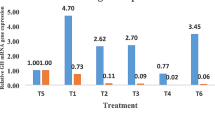Abstract
The effect of different feeding levels (ad libitum, 25 and 50 % restriction) and genotypes (½ Boer × ½ nondescript breed goats, Canindé, and Moxotó) on carcass quantitative characteristics and non-carcass components (NCC) were evaluated. Forty-five intact male goats were distributed in a 3 × 3 factorial design with five replicates. There was no effect of genotype on carcass weights and yields and retail cuts weights and yields (P > 0.05). Compared to Moxotó, ½ Boer presented better carcass conformation and higher weights (P < 0.01) and yields of viscera from gastrointestinal tract (P < 0.05), and compared to the other genotypes (P < 0.01), ½ Boer presented larger carcass compactness. Carcass weights and yields, retail cuts weights and NCC, and soft tissues yields were higher (P < 0.01) in goats fed ad libitum. The two restriction levels did not differ (P > 0.05) for these variables. There were interactions of genotype and feeding level. At ad libitum feeding, ½ Boer had higher weights of breast and shank, leg, soft tissues, and gastrointestinal viscera compared to the Moxotó (P < 0.05). The crossing of nondescript breed goats with Boer may be a strategy for increasing the efficiency of goat meat production in the Brazilian semiarid. Moreover, in times of feed scarcity, farmers may use higher feed restriction levels to keep animals, since for most of the parameters evaluated, there were no differences between the restriction levels.
Similar content being viewed by others
References
AOAC, 1990. Official Methods of Analysis, fifteenth ed. (Association of Official Analytical Chemist, Washington)
Bonvillani, A., Peña, F., Gea, G., Gomez, G., Petryna, A. and Perea, J., 2010. Carcass characteristics of Criollo Cordobés kid goats under an extensive management system: Effects of gender and live weight at slaughter, Meat Science, 86, 651--659
Browning Jr., R., Phelps, O., Chisley, C., Getz, W.R., Hollis, T. and Leite-Browning, M.L., 2012. Carcass yield traits of kids from a complete diallel of Boer, Kiko, and Spanish meat goat breeds semi-intensively managed on humid subtropical pasture, Journal of Animal Science, 90, 709--722
Butterfield, R.M., 1988. New concepts of sheep growth, (University of Sidney, Netley)
Carrasco, S., Ripoll, G., Sanz, A., Álvarez-Rodríguez, J., Panea, B., Revilla, R. and Joy, M., 2009. Effect of feeding system on growth and carcass characteristics of Churra Tensina light lambs, Livestock Science, 121, 56--63
Liméa, L., Boval, M., Mandonnet, N., Garcia, G., Archimede, H. and Alexandre, G., 2009. Growth performance, carcass quality, and noncarcass components of indigenous Caribbean goats under varying nutritional densities, Journal of Animal Science, 87, 3770--3781
Majdoub-Mathlouthi, L., Saïd, B., Say, A. and Kraiem, K., 2013. Effect of concentrate level and slaughter body weight on growth performances, carcass traits and meat quality of Barbarine lambs fed oat hay based diet, Meat Science, 93, 557--563
Medeiros, E.J.L., Mendonça, F.H.O., Queiroga, R.C.R.E. and Madruga, M.S., 2012. Meat quality characteristics of exotic and SPRD crossbred goats from the semiarid region, Ciência e Tecnologia de Alimentos, 32, 768--774
Mushi, D.E., Safari, J., Mtenga, L.A., Kifaro, G.C. and Eik, L.O., 2009a. Effects of concentrate levels on fattening performance, carcass and meat quality attributes of Small East African × Norwegian crossbred goats fed low quality grass hay, Livestock Science, 124, 148--155
Mushi, D.E., Safari, J., Mtenga, L.A., Kifaro, G.C. and Eik, L.O., 2009b. Growth and distribution of non-carcass components of Small East African and F1 Norwegian crossbred goats under concentrate diets, Livestock Science, 126, 80--86
Ngwa, A.T., Dawson, L.J., Puchala, R., Detweiler, G.D., Merkel, R.C., Wang, Z., Tesfai, K., Sahlu, T., Ferrell, C.L. and Goetsch, A.L, 2009. Effects of breed and diet on growth and body composition of crossbred Boer and Spanish wether goats, Journal of Animal Science, 87, 2913--2923
NRC, 2007. Nutrient Requirements of Small Ruminants: Sheep, goats, cervids, and new world camelids, (National Academy Press, Washington)
Panea, B., Ripoll, G., Horcada, A., Sañudo, C., Teixeira, A. and Alcalde, M.J., 2012. Influence of breed, milk diet and slaughter weight on carcass traits of suckling kids from seven Spanish breeds, Spanish Journal of Agricultural Research, 4, 1025--1036
SAS, 2003. User’s guide: version 9.1., (SAS Inc, Cary)
Silva, A.S., Furtado, D.A., Medeiros, A.N., Costa, R.G., Cezar, M.F. and Pereira Filho, J.M., 2011. Characteristics of carcass and non-carcass components in feedlot native goats in the Brazilian semiarid region, Revista Brasileira de Zootecnia, 40, 1815--1821
Solaiman, S., Min, B.R., Gurung, N., Behrends, J. and McElhenney, W., 2012. Effects of breed and harvest age on feed intake, growth, carcass traits, blood metabolites, and lipogenic gene expression in Boer and Kiko goats, Journal of Animal Science, 90, 2092--2108
Sousa, W.H., Brito, E.A., Medeiros, A.N., Cartaxo, F.Q., Cezar, M.F. and Cunha, M.G.G., 2009. Características morfométricas e de carcaça de cabritos e de cordeiros terminados em confinamento, Revista Brasileira de Zootecnia, 38, 1340--1346
Acknowledgments
We thank the Conselho Nacional de Pesquisa e Desenvolvimento (CNPq, Brazil), Coordenação de Aperfeiçoamento de Pessoal de Nível Superior (CAPES, Brazil) and Fundação de Amparo à Ciência e Tecnologia do Estado de Pernambuco (FACEPE, Brazil) for providing the financial support.
Conflicts of interest
There are no conflicts of interest among the authors of this research. All co-authors participated in the execution of the research and writing of this article, and agree with this final version.
Author information
Authors and Affiliations
Corresponding author
Rights and permissions
About this article
Cite this article
Martins, S.R., Chizzotti, M.L., Yamamoto, S.M. et al. Carcass and non-carcass component yields of crossbred Boer and Brazilian semiarid indigenous goats subjected to different feeding levels. Trop Anim Health Prod 46, 647–653 (2014). https://doi.org/10.1007/s11250-014-0545-1
Accepted:
Published:
Issue Date:
DOI: https://doi.org/10.1007/s11250-014-0545-1




